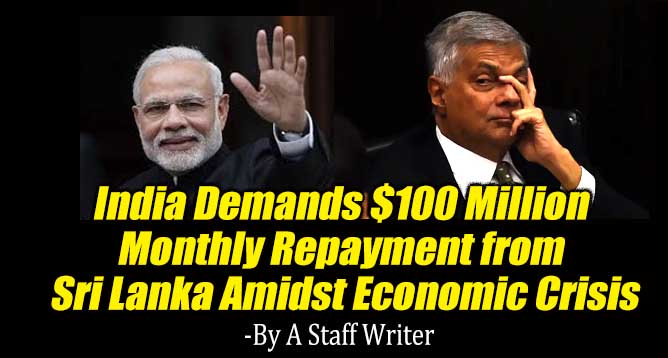-By A Staff Writer

(Lanka-e-News -28.Aug.2024, 11.45 pm) India has recently intensified its financial demands on Sri Lanka, requiring the island nation to repay $100 million per month for a $4 billion loan extended during Sri Lanka's economic crisis. This move comes as a surprise, as it deviates from the initial loan terms that included a more lenient grace period.
Sri Lanka, grappling with severe financial instability and having halted payments on external debts, faces significant pressure from India. The new repayment schedule reflects a shift in India's financial strategy, seemingly aimed at recovering the loan faster than initially agreed. The Indian government, led by Foreign Minister S. Jaishankar and Prime Minister Narendra Modi, has consistently portrayed itself as a key supporter of Sri Lanka's economic stability, citing the $4 billion loan as evidence of its commitment.
However, underlying concerns about China's growing influence in the region appear to be driving India's actions. India’s swift provision of the loan seems partly motivated by a desire to prevent Sri Lanka from turning to China for economic aid and forming closer economic ties. Additionally, the loan's terms included stipulations such as using Indian currency for certain payments and seeking defense agreements, further intertwining the financial aid with strategic interests.
The move to enforce a $100 million monthly repayment is at odds with the ongoing debt restructuring discussions involving the International Monetary Fund (IMF). The IMF's process, which includes potential debt write-downs, is complicated by India's refusal to agree to a haircut for its emergency loan. This refusal contrasts with India's public stance of aiding Sri Lanka and further complicates the debt restructuring landscape.
Critics argue that if India truly considers itself a friend of Sri Lanka, it should have agreed to a reduction in the loan amount to ease the financial burden on the struggling nation. Instead, India’s actions are seen as a strategic maneuver to safeguard its own interests, particularly in light of increasing Chinese involvement in the region. This dual-phase strategy - combining financial pressure with geopolitical maneuvering - highlights the complex interplay of international aid and diplomacy in the South Asian context.
---------------------------
by (2024-08-28 19:47:01)
Leave a Reply